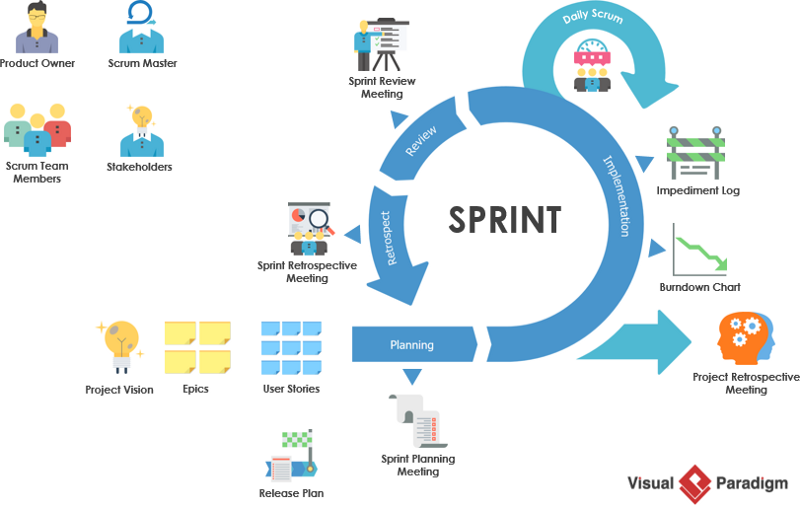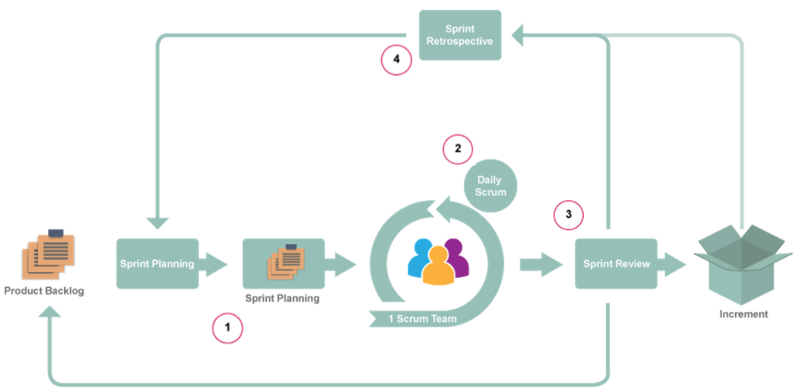اسکرام یک چارچوب است که در آن افراد میتوانند به مشکلات پیچیده و سازگار پاسخ دهند و در عین حال به طور مولد و خلاقانه محصولاتی با بالاترین ارزش ممکن ارائه دهند.
اسکرام خود یک چارچوب ساده برای همکاری مؤثر تیم در محصولات پیچیده است. خالقان اسکرام، کن شواب و جف ساترلند نوشتهاندراهنمای اسکرامتا اسکرام را به وضوح و به اختصار توضیح دهد. این راهنما شامل تعریف اسکرام است. این تعریف شامل نقشها، رویدادها، آثار و قوانینی است که آنها را به هم پیوند میدهد.
فرآیند اسکرام
در پروژههای چابک، یک اسپرینت یک تکرار ثابت از زمان است که در آن تیم توسعه یک گروه خاص از قابلیتهای محصول را از ابتدا تا انتها ایجاد میکند. در پایان هر اسپرینت، عملکردی که تیم توسعه ایجاد کرده باید کار کند، آماده نمایش باشد و احتمالاً قابل ارسال به مشتری باشد.

اسپرینتها باید در یک پروژه طول یکسانی داشته باشند. حفظ طولهای ثابت اسپرینت به تیم توسعه کمک میکند تا عملکرد خود را اندازهگیری کند و در هر اسپرینت جدید بهتر برنامهریزی کند.
اسپرینتها معمولاً بین یک تا چهار هفته طول میکشند. چهار هفته طولانیترین مدت زمانی است که هر اسپرینت باید طول بکشد؛ تکرارهای طولانیتر تغییرات را پرخطرتر میکند و هدف چابک بودن را زیر سوال میبرد. ما به ندرت میبینیم که اسپرینتها بیشتر از دو هفته طول بکشند و بیشتر اوقات اسپرینتها یک هفتهای هستند. اسپرینتهای یک هفتهای یک چرخه طبیعی با هفته کاری دوشنبه تا جمعه هستند که به طور ساختاری از کار در آخر هفته جلوگیری میکند.
برخی از تیمهای اسکرام در اسپرینتهای یک روزه کار میکنند که در آن اولویتها به صورت روزانه تغییر میکنند. نیازهای بازار و مشتری به سرعت در حال تغییر است و مدت زمانی که میتوانید بین فرصتها برای جمعآوری بازخورد مشتری صرف کنید، فقط کوتاهتر میشود.
قاعده کلی ما این است که اسپرینت شما نباید طولانیتر از زمانی باشد که ذینفعان شما میتوانند به طور مداوم بدون تغییر در اولویتها در مورد اینکه تیم اسکرام باید در اسپرینت روی چه چیزی کار کند، پیش بروند.
- هر اسپرینت شامل موارد زیر است
- برنامهریزی اسپرینت در ابتدای اسپرینت، جلسات روزانه اسکرام
- زمان توسعه — بخش عمده اسپرینت
- یک بازبینی اسپرینت و یک مرور اسپرینت در پایان اسپرینت

بیشتر درباره اسکرام بیاموزید – مبنای چابک و اسکرام
- راهنمای جامع اسکرام
- سه رکن اسکرام چیست؟
- توسعه نرمافزار چابک چیست؟
- اسکرام در ۳ دقیقه
- ۵ ارزش اسکرام چیست؟
- تکامل اسکرام چیست؟
- مدیریت پروژه کلاسیک در مقابل مدیریت پروژه چابک
- چرا تسلط بر اسکرام دشوار است؟
- سرعت در اسکرام چیست؟
- چابک چیست؟ اسکرام چیست؟
- استراتژی توسعه سه دوست در چابک چیست؟
- کنترل فرآیند تجربی در مقابل کنترل فرآیند تعریف شده
- چگونه شفافیت را در اسکرام حفظ کنیم؟
- اسکرام در مقابل آبشاری در مقابل چابک در مقابل لاغر در مقابل کانبان
- عدد ۳۳۵۵ در چارچوب اسکرام چیست؟
- چرا اسکرام؟ اسکرام چگونه بر ۸ نقطه درد که همیشه با آن مواجه هستیم غلبه میکند؟
- بهترین ابزارهای چابک رایگان و تجاری — هر تیم اسکرام به آنها نیاز دارد!
- ۸ ضایعات در لاغری چیست؟
- برنامهنویسی افراطی (XP) در مقابل اسکرام
- زمانبندی در اسکرام چیست؟
- افسانه چابک: آیا مستندسازی و برنامهریزی لازم نیست؟
This post is also available in Deutsch, English, Español, Français, Bahasa Indonesia, 日本語, Polski, Portuguese, Ру́сский, Việt Nam, 简体中文 and 繁體中文.













